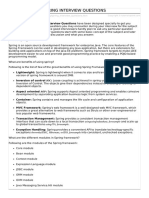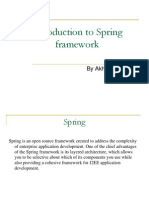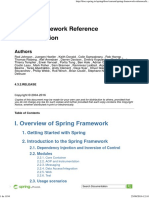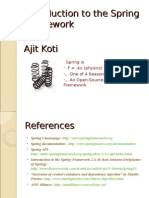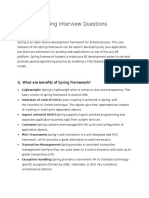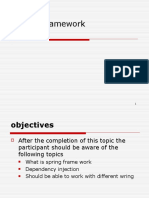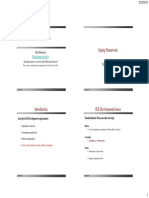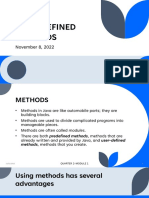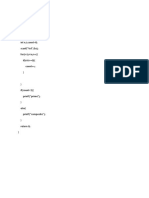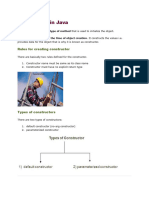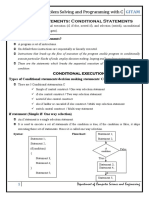Spring Framework Introduction
Uploaded by
Toàn Trần Trung (Toàn)Spring Framework Introduction
Uploaded by
Toàn Trần Trung (Toàn)SPRING FRAMEWORK
Design by: DieuNT1
09e-BM/DT/FSOFT - @FPT SOFTWARE - FPT Software Academy - Internal Use
Agenda
1. Overview of the Spring Framework
2. Spring IoC
3. Spring Bean
4. Dependency Injection
5. Autowiring in Spring
6.
5. Question and Answer
09e-BM/DT/FSOFT - @FPT SOFTWARE - FPT Software Academy - Internal Use 2
Lesson Objectives
• Understand Spring Framework and its core technologies.
1
• Understand the architectural components of the Spring Framework: IoC, DI
2
• Understand the Spring modules
3
• Able to Setting up a Spring Development Environment
4
• Creating and Configuring Spring Applications
5
09e-BM/DT/FSOFT - @FPT SOFTWARE - FPT Software Academy - Internal Use 3
Section 1
Overview of the Spring Framework
09e-BM/DT/FSOFT - @FPT SOFTWARE - FPT Software Academy - Internal Use 4
Introduction
▪ The Spring Framework is a Java platform that provides comprehensive infrastructure support
for developing Java applications.
▪ Spring framework is one of the most popular application development frameworks used by
java developers.
09e-BM/DT/FSOFT - @FPT SOFTWARE - FPT Software Academy - Internal Use 5
Introduction
▪ Spring framework consists of a large number of modules providing a range
of services:
✓ Core Container;
✓ Data Access/Integration;
✓ Web;
✓ Test
✓ AOP (Aspect Oriented Programming);
✓ Instrumentation;
✓ Messaging;
09e-BM/DT/FSOFT - @FPT SOFTWARE - FPT Software Academy - Internal Use 6
Spring Modules
▪ Data Access/Integration
✓ JDBC module provides a JDBC-abstraction layer
✓ ORM (object-relational mapping APIs): integrate with JPA, JDO, Hibernate, and iBatis.
✓ OXM (Object/XML mapping) implemente for JAXB, Castor, XMLBeans, JiBX and
XStream.
✓ JMS (Java messaging service): producing and consuming messages.
✓ Transaction: supports programmatic and declarative transaction management.
09e-BM/DT/FSOFT - @FPT SOFTWARE - FPT Software Academy - Internal Use 7
Spring Modules
▪ Web
✓ Web: Support some features in web application such as : file upload, file download
✓ Web-Servlet: contains Spring's model-view-controller (MVC) implementation for web
applications
✓ Web-Struts: contains the support classes for integrating a classic Struts web tier (struts 1
or struts 2) within a Spring application
✓ Web-Portlet module provides the MVC implementation to be used in a portlet environment
and mirrors the functionality of Web-Servlet module.
09e-BM/DT/FSOFT - @FPT SOFTWARE - FPT Software Academy - Internal Use 8
Spring Modules
▪ AOP and Instrument
✓ Spring's AOP module provides an AOP Alliance-compliant aspect-oriented programming
implementation allowing you to define
✓ Aspects module provides integration with AspectJ.
✓ Instrumentation module provides class instrumentation support and classloader
implementations to be used in certain application servers.
▪ Test
✓ The Test module supports the testing of Spring components with JUnit or TestNG
09e-BM/DT/FSOFT - @FPT SOFTWARE - FPT Software Academy - Internal Use 9
History of Spring Framework
In October 2002 by Rod Johnson;
✓ He proposed a simpler solution based on ordinary java classes (POJO – plain old java objects) and
dependency injection (DI or IoC).
✓ In June 2003, spring 0.9 was released under Apache 2.0 license;
✓ 6.1.x is the upcoming feature branch (November 2023).
✓ 6.0.x is the main production line as of November 2022. This new generation of the framework comes with a
JDK 17 and Jakarta EE 9 baseline.
✓ 5.3.x is the final feature branch of the 5th generation, with long-term support provided on JDK 8, JDK 11, JDK
17 and the Java EE 8 level.
✓ 4.3.x reached its official EOL (end-of-life) on December 31st, 2020. No further maintenance and security
patches are planned in that line.
✓ 3.2.x reached its official EOL (end-of-life) on December 31st, 2016. No further maintenance and security
patches are planned in that line.
09e-BM/DT/FSOFT - @FPT SOFTWARE - FPT Software Academy - Internal Use 10
Section 2
Spring IOC Container Overview
09e-BM/DT/FSOFT - @FPT SOFTWARE - FPT Software Academy - Internal Use 11
What We'll Learn?
1. What Is the Spring Container?
2. What is Configuration Metadata?
3. How to Create a Spring Container?
4. How to Retrieve Bean from Spring Container?
5. Spring IOC Container XML Config Example
6. Spring IOC Container Java Config Example
09e-BM/DT/FSOFT - @FPT SOFTWARE - FPT Software Academy - Internal Use 12
What is the Spring Container?
The Spring container is responsible for instantiating, configuring, and assembling the
Spring beans.
The container gets its instructions on what objects to instantiate, configure, and
assemble by reading configuration metadata.
▪ The configuration metadata is represented in XML, Java annotations, or
Java code.
▪ The responsibilities of IOC container are:
✓ Instantiating the bean
✓ Wiring the beans together
✓ Configuring the beans
✓ Managing the bean’s entire life-cycle
09e-BM/DT/FSOFT - @FPT SOFTWARE - FPT Software Academy - Internal Use 13
What is the Spring Container?
▪ The org.springframework.beans and org.springframework.context pa
-ckages are the basis for Spring Framework’s IoC container.
▪ Spring framework provides two distinct types of containers:
✓ BeanFactory container
✓ ApplicationContext container
One main difference between BeanFactory and ApplicationContext is that BeanFactory only
instantiates bean when we call getBean() method while ApplicationContext instantiates singleton bean
when the container is started, It doesn't wait for getBean() method to be called.
BeanFactory is the root interface of Spring IOC container. ApplicationContext is the child
interface of BeanFactory interface that provides Spring AOP features, i18n etc.
09e-BM/DT/FSOFT - @FPT SOFTWARE - FPT Software Academy - Internal Use 14
Types Of IoC Container
09e-BM/DT/FSOFT - @FPT SOFTWARE - FPT Software Academy - Internal Use 15
What is Spring Inversion of Control (IoC )?
▪ Let’s first understand the issue, consider the following class:
package com.fsoft.bean;
public class Employee {
private int empId;
private String empName;
private String address;
public Employee() {
public Employee(int empId, String empName, String address) {
this.empId = empId;
this.empName = empName;
this.address = address;
}
//getter-setter methods
}
09e-BM/DT/FSOFT - @FPT SOFTWARE - FPT Software Academy - Internal Use 16
Spring IoC
▪ Standard code that without IoC
package com.fsoft.bean;
Employee
-------------------------- public class Client {
- empId Client public static void main(String[] args) {
- empName ------------------------- Employee employee = new Employee();
- address + main()
-------------------------- employee.setEmpId(1);
+ getter employee.setEmpName("John Watson");
+ setter
employee.setAddress("New York");
System.out.println("Employee details: " + employee);
}
}
09e-BM/DT/FSOFT - @FPT SOFTWARE - FPT Software Academy - Internal Use 17
Spring IoC
▪ With IoC
✓ You don’t create objects. Using Bean Configuration File;
✓ Create an application context where we used framework API ClassPathXmlApplicationContext().
✓ This API loads beans configuration file and based on the provided API, it will create and initialize all
the objects.
Employee
----------------
- empId Client
- empName -------------
- address Container + main()
----------------
+ getter
+ setter
09e-BM/DT/FSOFT - @FPT SOFTWARE - FPT Software Academy - Internal Use 18
What is Configuration Metadata?
▪ Spring IoC container consumes a form of configuration metadata.
▪ Three ways we can supply Configuration Metadata to Spring IoC container
✓ XML-based configuration
✓ Annotation-based configuration
✓ Java-based configuration
09e-BM/DT/FSOFT - @FPT SOFTWARE - FPT Software Academy - Internal Use 19
How to Create a Spring Container?
Spring provides many ApplicationContext interface implementations that we
use are:
▪ AnnotationConfigApplicationContext: using Spring in standalone Java applications and using
annotations for Configuration.
AnnotationConfigApplicationContext context = new
AnnotationConfigApplicationContext(AppConfig.class);
Note that we are supplying configuration metadata via applicationContext.xml file(XML-based
configuration).
09e-BM/DT/FSOFT - @FPT SOFTWARE - FPT Software Academy - Internal Use 20
How to Create a Spring Container?
▪ ClassPathXmlApplicationContext: spring bean configuration XML file in a standalone
application.
ApplicationContext context = new ClassPathXmlApplicationContext("applicationContext.xml");
Note that we are supplying configuration metadata via AppConfig.class file.
▪ FileSystemXmlApplicationContext: This is similar to ClassPathXmlApplicationContext except
that the XML configuration file can be loaded from anywhere in the file system.
AnnotationConfigWebApplicationContext and XmlWebApplicationContext for web applications.
09e-BM/DT/FSOFT - @FPT SOFTWARE - FPT Software Academy - Internal Use 21
How to Retrieve Bean from Spring Container?
ApplicationContext getBean() Example:
ApplicationContext context = new ClassPathXmlApplicationContext("applicationContext.xml");
HelloWorld obj = (HelloWorld) context.getBean("helloWorld");
BeanFactory getBean() Example:
XmlBeanFactory factory = new XmlBeanFactory (new ClassPathResource("beans.xml"));
HelloWorld obj = (HelloWorld) factory.getBean("helloWorld");
09e-BM/DT/FSOFT - @FPT SOFTWARE - FPT Software Academy - Internal Use 22
Spring IOC Container XML Config Example
1. Create a simple Maven Project
2. Add Maven Dependencies
3. Configure HelloWorld Spring Beans
4. Create a Spring Container
5. Retrieve Beans from Spring Container
09e-BM/DT/FSOFT - @FPT SOFTWARE - FPT Software Academy - Internal Use 23
Spring IOC Container XML Config Example
Tools and technologies used
▪ Spring Framework - 6.x
▪ JDK - 17 or later
▪ Maven - 3.2+
▪ IDE - Eclipse/STS
09e-BM/DT/FSOFT - @FPT SOFTWARE - FPT Software Academy - Internal Use 24
Spring IOC Container XML Config Example
▪ Add maven dependency in pom.xml file.
<properties>
<project.build.sourceEncoding>UTF-8</project.build.sourceEncoding>
<maven.compiler.source>17</maven.compiler.source>
<maven.compiler.target>17</maven.compiler.target>
<spring.version>6.0.10</spring.version>
</properties>
<!-- https://mvnrepository.com/artifact/org.springframework/spring-core -->
<dependency>
<groupId>org.springframework</groupId>
<artifactId>spring-core</artifactId>
<version>${spring.version}</version>
</dependency>
<!-- https://mvnrepository.com/artifact/org.springframework/spring-context -->
<dependency>
<groupId>org.springframework</groupId>
<artifactId>spring-context</artifactId>
<version>${spring.version}</version>
</dependency>
09e-BM/DT/FSOFT - @FPT SOFTWARE - FPT Software Academy - Internal Use 25
Spring IOC Container XML Config Example
▪ Add maven dependency in pom.xml file.
<!-- https://mvnrepository.com/artifact/org.springframework/spring-beans -->
<dependency>
<groupId>org.springframework</groupId>
<artifactId>spring-beans</artifactId>
<version>${spring.version}</version>
</dependency>
09e-BM/DT/FSOFT - @FPT SOFTWARE - FPT Software Academy - Internal Use 26
Spring IOC Container XML Config Example
▪ Create Bean Configuration File
package fa.training.entities;
public class Book {
private int bookId;
private String title;
private int year;
private String version;
// getter, setter and constructor methods
}
09e-BM/DT/FSOFT - @FPT SOFTWARE - FPT Software Academy - Internal Use 27
Spring IOC Container XML Config Example
▪ Create Bean Configuration File
context.xml <?xml version="1.0" encoding="UTF-8"?>
<beans xmlns="http://www.springframework.org/schema/beans"
xmlns:xsi="http://www.w3.org/2001/XMLSchema-instance"
xmlns:context="http://www.springframework.org/schema/context"
xsi:schemaLocation="http://www.springframework.org/schema/beans
http://www.springframework.org/schema/beans/spring-beans.xsd
http://www.springframework.org/schema/context
http://www.springframework.org/schema/context/spring-context.xsd">
<bean id="book" class="fa.training.entities.Book">
<constructor-arg name="bookId" type="int" value="1" />
<constructor-arg name="title" value="Java SE Programming Language" />
<constructor-arg name="year" type="int" value="2023" />
<constructor-arg name="version" value="2" />
</bean>
</beans>
09e-BM/DT/FSOFT - @FPT SOFTWARE - FPT Software Academy - Internal Use 28
Spring IoC Demo
▪ Create a Spring Container
public class Client {
public static void main(String[] args) {
ApplicationContext context = new
ClassPathXmlApplicationContext("context.xml");
Book book = (Book) context.getBean("book");
AppLogUtils.getLog().info(book);
}
}
Result
[INFO ] 2023-08-23 11:18:35 [main] Main 20 - Book(bookId=1, title=Java SE Programming Language, year=2023, version=2)
09e-BM/DT/FSOFT - @FPT SOFTWARE - FPT Software Academy - Internal Use 29
IOC Container Features
The Spring IoC container by using Java POJO classes and configuration metadata
procedures a fully configured and executable system or application.
09e-BM/DT/FSOFT - @FPT SOFTWARE - FPT Software Academy - Internal Use 30
Section 3
Spring Beans
09e-BM/DT/FSOFT - @FPT SOFTWARE - FPT Software Academy - Internal Use 31
Bean Object
Beans are the objects that form the backbone of our application and are managed by the
Spring IoC container.
Spring IoC container instantiates, assembles, and manages the bean object.
The configuration metadata that are supplied to the container are used create Beans
object.
09e-BM/DT/FSOFT - @FPT SOFTWARE - FPT Software Academy - Internal Use 32
Some Bean Properties
Property Explain
class This attribute is mandatory and specify the bean class to be used to create the bean.
This attribute specifies the bean identifier uniquely. In XML-based configuration metadata, you
name
use the id and/or name attributes to specify the bean identifier(s).
scope This attribute specifies the scope of the objects created from a particular bean definition.
constructor-arg This is used to inject the dependencies and will be discussed in subsequent chapters.
property Define properties of class.
autowire Set autowire for bean.
A lazy-initialized bean tells the IoC container to create a bean instance when it is first
lazy-init
requested, rather than at startup.
09e-BM/DT/FSOFT - @FPT SOFTWARE - FPT Software Academy - Internal Use 33
class property
package com.fsoft.bean;
public class Address {
private String city;
private String street;
public Address() {
public Address(String city, String street) {
this.city = city;
this.street = street;
}
// getter-setter methods
}
<?xml version="1.0" encoding="UTF-8"?>
<beans xmlns="http://www.springframework.org/schema/beans"
xmlns:xsi="http://www.w3.org/2001/XMLSchema-instance"
xsi:schemaLocation="http://www.springframework.org/schema/beans
http://www.springframework.org/schema/beans/spring-beans.xsd">
<bean id="addr" class="com.fsoft.bean.Address">
<property name="city" value="Hanoi" />
<property name="street" value="Duytan" />
</bean>
</beans>
09e-BM/DT/FSOFT - @FPT SOFTWARE - FPT Software Academy - Internal Use 34
scope property
Scope Explain
(Default) Scopes a single bean definition to a single object instance per Spring IoC
singleton
container.
prototype Scopes a single bean definition to any number of object instances.
Scopes a single bean definition to the lifecycle of a single HTTP request; that is, each
request HTTP request has its own instance of a bean created off the back of a single bean
definition.
Scopes a single bean definition to the lifecycle ofcan HTTP Session. Only valid in the
session
context of acweb-aware Spring ApplicationContext.
Scopes a single bean definition to the lifecycle of a global HTTP Session. Typically only
global session valid when used in a portlet context. Only valid in the context of a web-aware Spring
ApplicationContext.
application The application scope creates the bean instance for the lifecycle of a ServletContext.
The same instance of the bean is then returned whenever that bean is accessed during
websocket
the entire WebSocket session.
09e-BM/DT/FSOFT - @FPT SOFTWARE - FPT Software Academy - Internal Use 35
scope property
▪ Scope “singleton”
09e-BM/DT/FSOFT - @FPT SOFTWARE - FPT Software Academy - Internal Use 36
scope property
▪ Scope “prototype”
09e-BM/DT/FSOFT - @FPT SOFTWARE - FPT Software Academy - Internal Use 37
Section 4
Spring DI
09e-BM/DT/FSOFT - @FPT SOFTWARE - FPT Software Academy - Internal Use 38
Dependency Injection (DI)
It is a design pattern which removes the dependency from the programming code, that makes
the Application easy to manage and test.
Dependency Injection makes our programming code loosely coupled, which means change in
implementation doesn't affects the use.
09e-BM/DT/FSOFT - @FPT SOFTWARE - FPT Software Academy - Internal Use 39
Spring DI
▪ Consider you have an application which has a employee component and you
want to identify a their address.
▪ Your standard code would look something like this:
public class Employee {
private int empId;
private String empName;
private Address address; // HAS-A relationship
/*private String address;*/
public Employee() {
this.empId = 0;
this.empName = "N/A";
this.address = new Address();
}
}
09e-BM/DT/FSOFT - @FPT SOFTWARE - FPT Software Academy - Internal Use 40
Spring DI
▪ Let's create a dependency between the Employee and the Address.
▪ In an IoC scenario, we would instead do something like this:
public class Employee {
private int empId;
private String empName;
private Address address; // HAS-A relationship
public Employee(Address address) {
super();
this.address = address;
}
public void setAddress(Address address) {
this.address = address;
}
}
▪ We can inject the dependancies using the setter or constructor injection.
09e-BM/DT/FSOFT - @FPT SOFTWARE - FPT Software Academy - Internal Use 41
Type of Dependency Injection
09e-BM/DT/FSOFT - @FPT SOFTWARE - FPT Software Academy - Internal Use 42
Spring DI Demo
▪ By Constructor
<?xml version="1.0" encoding="UTF-8"?>
<beans xmlns="http://www.springframework.org/schema/beans"
xmlns:xsi="http://www.w3.org/2001/XMLSchema-instance"
xsi:schemaLocation="http://www.springframework.org/schema/beans
http://www.springframework.org/schema/beans/spring-beans.xsd">
<bean id="addr" class="com.fsoft.bean.di.Address">
<property name="city" value="Hanoi" />
<property name="street" value="Duytan" />
</bean>
<bean id="emp3" class="com.fsoft.bean.di.Employee">
<property name="empId" value="3"/>
<property name="empName" value="My"/>
<property name=" address " ref="addr">/> <--setter-->
<constructor-arg name="address" ref="addr“ />
</bean>
</beans>
Using <constructor-arg> subelement to initialize
instance variables
09e-BM/DT/FSOFT - @FPT SOFTWARE - FPT Software Academy - Internal Use 43
Spring DI Demo
▪ By Setter
<?xml version="1.0" encoding="UTF-8"?>
<beans xmlns="http://www.springframework.org/schema/beans"
xmlns:xsi="http://www.w3.org/2001/XMLSchema-instance"
xsi:schemaLocation="http://www.springframework.org/schema/beans
http://www.springframework.org/schema/beans/spring-beans.xsd">
<bean id="addr" class="com.fsoft.bean.di.Address">
<property name="city" value="Hanoi" />
<property name="street" value="Duytan" />
</bean>
<bean id="emp4" class="com.fsoft.bean.di.Employee">
<property name="empId" value="4"/>
<property name="empName" value="My"/>
<property name="address" ref="addr“ />
</bean>
</beans>
Using <property> subelement to initialize instance
variables
09e-BM/DT/FSOFT - @FPT SOFTWARE - FPT Software Academy - Internal Use 44
Spring IOC and DI
▪ Ways of implement IOC
IOC
DI
Interface
Constructor Setter/Getter Service Locator
Implementation
09e-BM/DT/FSOFT - @FPT SOFTWARE - FPT Software Academy - Internal Use 45
Section 5
Autowiring in Spring
09e-BM/DT/FSOFT - @FPT SOFTWARE - FPT Software Academy - Internal Use 46
Introduction
▪ Spring provides a way to automatically detect the relationships between
various beans
▪ The XML-configuration-based autowiring functionality has five modes –
no, byName, byType, constructor, and default. The default mode is no.
09e-BM/DT/FSOFT - @FPT SOFTWARE - FPT Software Academy - Internal Use 47
Example classes
public class Department { public class Employee {
private String deptName; private int eid;
private String ename;
public String getDeptName() { private Department department;
return deptName;
} // getter, setter and constructor methods
public void setDeptName(String deptName) { public void showEployeeDetails() {
this.deptName = deptName; System.out.println("Employee Id : " + eid);
} System.out.println("Employee Name : " + ename);
} System.out.println("Department : "
+ department.getDeptName());
}
}
09e-BM/DT/FSOFT - @FPT SOFTWARE - FPT Software Academy - Internal Use 48
Autowiring Modes
▪ no: It’s the default autowiring mode. It means no autowiring.
▪ byName: The byName mode injects the object dependency according to name of the bean.
✓ In such a case, the property and bean name should be the same.
✓ It internally calls the setter method.
..
<bean id="department" class="fa.training.entities.Department">
<property name="deptName" value="Information Technology" />
</bean>
<bean id="employee" class="fa.training.entities.Employee" autowire="byName">
<property name="eid" value="100"/>
<property name="ename" value="100"/>
</bean>
Employee employee = (Employee) applicationContext.getBean("employee");
employee.showEployeeDetails();
Output:
Employee Id : 100
Employee Name : 100
Department : Information Technology
09e-BM/DT/FSOFT - @FPT SOFTWARE - FPT Software Academy - Internal Use 49
Autowiring Modes
▪ byType: The byType mode injects the object dependency according to type.
✓ So it can have a different property and bean name.
✓ It internally calls the setter method.
..
<bean id="dept" class="fa.training.entities.Department">
<property name="deptName" value="Information Technology" />
</bean>
<bean id="employee" class="fa.training.entities.Employee" autowire="byType">
<property name="eid" value="100"/>
<property name="ename" value="100"/>
</bean>
09e-BM/DT/FSOFT - @FPT SOFTWARE - FPT Software Academy - Internal Use 50
Autowiring Modes
▪ constructor: The constructor mode injects the dependency by calling the constructor
of the class.
✓ It calls the constructor having a large number of parameters.
..
<bean id="dept" class="fa.training.entities.Department">
<property name="deptName" value="Information Technology" />
</bean>
<bean id="employee" class="fa.training.entities.Employee" autowire="constructor">
<property name="eid" value="100"/>
<property name="ename" value="100"/>
</bean>
class Employee {
public Employee(Department department) {
super();
this.department = department;
}
}
09e-BM/DT/FSOFT - @FPT SOFTWARE - FPT Software Academy - Internal Use 51
Summary
Overview of the Spring Framework
Spring IoC
Spring Bean
Dependency Injection
Autowiring in Spring
Questions and Answers
09e-BM/DT/FSOFT - @FPT SOFTWARE - FPT Software Academy - Internal Use 52
THANK YOU!
09e-BM/DT/FSOFT - @FPT SOFTWARE - FPT Software Academy - Internal Use
You might also like
- Spring Framework: Java Enterprise Application GuideNo ratings yetSpring Framework: Java Enterprise Application Guide27 pages
- Preguntas de Entrevista de Trabajo - SpringNo ratings yetPreguntas de Entrevista de Trabajo - Spring12 pages
- Spring-Framework - Optimize - Chapter 2. Core TechnologiesNo ratings yetSpring-Framework - Optimize - Chapter 2. Core Technologies478 pages
- Introduction To Spring Framework: by Akhilesh JaiswalNo ratings yetIntroduction To Spring Framework: by Akhilesh Jaiswal25 pages
- Inversion of Control: Introduction To SpringNo ratings yetInversion of Control: Introduction To Spring45 pages
- Spring Framework Reference Documentation PDFNo ratings yetSpring Framework Reference Documentation PDF1,194 pages
- Spring J2EE Framework: Ram A. Rao May 15 05No ratings yetSpring J2EE Framework: Ram A. Rao May 15 0553 pages
- Introduction To The Spring Framework Ajit KotiNo ratings yetIntroduction To The Spring Framework Ajit Koti46 pages
- Introduction To Spring Framework and Dependency Injection: Aaron ZeckoskiNo ratings yetIntroduction To Spring Framework and Dependency Injection: Aaron Zeckoski31 pages
- Spring Interview Questions: Q. What Is Spring?No ratings yetSpring Interview Questions: Q. What Is Spring?20 pages
- Introduction To The Spring: Vamsi Mohan.VNo ratings yetIntroduction To The Spring: Vamsi Mohan.V27 pages
- Unit - 5 Spring Framework and SpringBoot Sachin SirNo ratings yetUnit - 5 Spring Framework and SpringBoot Sachin Sir39 pages
- Fundamentals of Python Programming (Part 1)No ratings yetFundamentals of Python Programming (Part 1)18 pages
- SQL Stored Procedures With Multiple Parameters.No ratings yetSQL Stored Procedures With Multiple Parameters.2 pages
